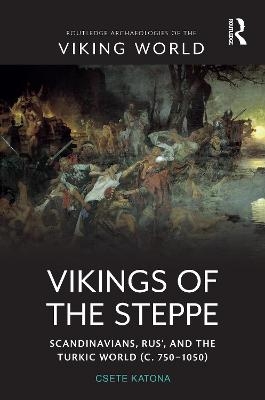
Vikings of the Steppe
Scandinavians, Rus’, and the Turkic World (c. 750–1050)
Seiten
2022
Routledge (Verlag)
978-0-367-48075-2 (ISBN)
Routledge (Verlag)
978-0-367-48075-2 (ISBN)
This book explores the relationship between Vikings, Rus’ and nomadic (mostly Turkic) steppe dwellers during the course of the Viking Age (c. 750–1050) in a geographical area stretching from Eastern Scandinavia through the Kievan Rus’, Byzantium, the Islamic world to the Western Eurasian steppes.
The primary focus is the steppe influence on the development of Scandinavian-Rus’ culture. It illustrates the effects of Turkic (nomadic) cultures on the evolving Scandinavian-Rus’ communities in their military technology and tactics, as well as in everyday customs, ritual traditions and religious perceptions, whilst paying attention to the politico-commercial necessities and possible communication channels tying these two cultures, normally considered to be distinct, together. The arguments are supported by a multi-disciplinary analysis of diverse historical and archaeological materials occasionally supplemented with linguistic evidence. The result is a comprehensive evaluation of the relations of the Scandinavians active in the ‘East’ with Turkic groups, and brings (the so far neglected) steppes into Viking studies in general.
The book will fill a serious scholarly gap in the field of Viking studies and will be read by both academics and students interested in the archaeological and historical sources concerned with the traditions of the ‘Eastern Vikings’.
The primary focus is the steppe influence on the development of Scandinavian-Rus’ culture. It illustrates the effects of Turkic (nomadic) cultures on the evolving Scandinavian-Rus’ communities in their military technology and tactics, as well as in everyday customs, ritual traditions and religious perceptions, whilst paying attention to the politico-commercial necessities and possible communication channels tying these two cultures, normally considered to be distinct, together. The arguments are supported by a multi-disciplinary analysis of diverse historical and archaeological materials occasionally supplemented with linguistic evidence. The result is a comprehensive evaluation of the relations of the Scandinavians active in the ‘East’ with Turkic groups, and brings (the so far neglected) steppes into Viking studies in general.
The book will fill a serious scholarly gap in the field of Viking studies and will be read by both academics and students interested in the archaeological and historical sources concerned with the traditions of the ‘Eastern Vikings’.
Csete Katona earned a PhD in History at the University of Debrecen. Currently, he is a PhD candidate at Central European University and employed as a research assistant at Pázmány Péter Catholic University. His research interest is the Vikings in the East, on which he has several publications in English and Hungarian.
1: Introduction; 2: The steppe and the Viking world; 3: Armed conflicts; 4: Trade; 5: Retinues; 6: Customs and religion(s); 7: Communication; Conclusions; Bibliography; Index.
| Erscheinungsdatum | 14.09.2022 |
|---|---|
| Reihe/Serie | Routledge Archaeologies of the Viking World |
| Zusatzinfo | 3 Tables, black and white; 19 Halftones, black and white; 19 Illustrations, black and white |
| Verlagsort | London |
| Sprache | englisch |
| Maße | 156 x 234 mm |
| Gewicht | 540 g |
| Themenwelt | Geisteswissenschaften ► Archäologie |
| Geschichte ► Allgemeine Geschichte ► Mittelalter | |
| Geisteswissenschaften ► Geschichte ► Regional- / Ländergeschichte | |
| ISBN-10 | 0-367-48075-1 / 0367480751 |
| ISBN-13 | 978-0-367-48075-2 / 9780367480752 |
| Zustand | Neuware |
| Haben Sie eine Frage zum Produkt? |
Mehr entdecken
aus dem Bereich
aus dem Bereich
eine neue Geschichte des Mittelalters
Buch | Hardcover (2023)
C.H.Beck (Verlag)
38,00 €


